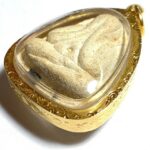What is the Significance of Ancient Thai Buddhist Amulets?

Ancient Thai Buddhist amulets hold great significance in Thai culture and tradition. These sacred objects are believed to embody the spiritual power and blessings of revered Buddhist monks, and are often worn or carried as a means of protection, spiritual connection, and personal growth. Thai Buddhist amulets are typically made from a variety of materials, including precious metals, bone, and clay, and are often adorned with intricate designs and inscriptions. The production of Thai Buddhist amulets is a deeply spiritual process that involves the creation of a sacred image or object, which is then blessed and imbued with spiritual power by a revered monk or spiritual leader. The amulets are often created in limited quantities, and are highly prized by collectors and spiritual seekers alike.
Thai Buddhist amulets are believed to offer a range of benefits to those who wear or possess them, including protection from harm, good fortune, and spiritual guidance. They are also believed to promote healing, peace, and well-being, and are often used as a means of connecting with the divine and cultivating a deeper spiritual practice.
In addition to their spiritual significance, Thai Buddhist amulets are also an important part of Thai cultural heritage. They serve as a tangible connection to the rich history and traditions of Thai Buddhism, and are often passed down from generation to generation as treasured family heirlooms. The study and collection of Thai Buddhist amulets is a popular hobby, and there are numerous books, websites, and museums dedicated to this fascinating aspect of Thai culture.

Thai Buddhist amulets have long been revered for their ability to connect individuals with the spiritual power and blessings of renowned monks, promoting and inspiring for personal growth and well-being, and serving as a tangible link to the rich history and traditions of Thai Buddhism. These sacred objects are cherished for their protective qualities, spiritual guidance, and cultural significance, and continue to play an important role in Thai culture and heritage




